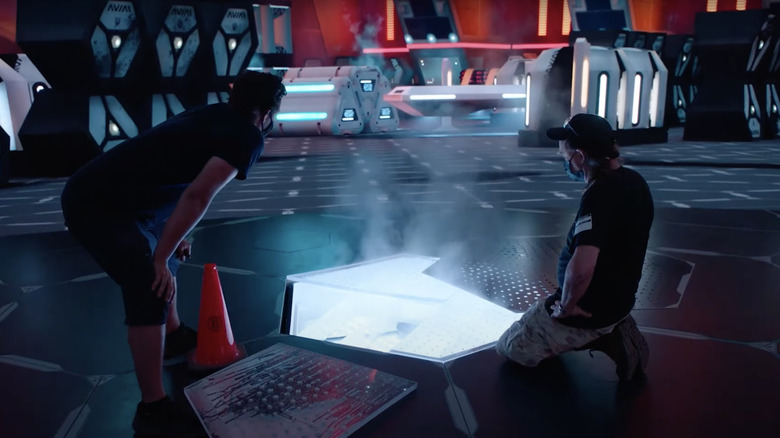Star Trek: Discovery Uses Suspiciously Holodeck-Like Technology While Filming
While William Shatner, the first TV captain of the starship Enterprise, has been busy taking real trips to space (and occasionally writing about it for /Film), the current flagship series of the franchise, "Star Trek: Discovery," has been busy bringing us one step closer to a real-life Holodeck. Season 4 of "Discovery," now streaming on Paramount+, has been using a new-fangled technology called the AR wall to shoot scenes. AR stands for "augmented reality," and while the AR wall is not quite a full 360-degree Holodeck (as seen on "Star Trek: The Next Generation"), it's pretty darn close.
The virtual production company, Pixomondo, has posted a new behind-the-scenes video that shows how the AR wall has helped revolutionize the production of "Star Trek: Discovery." Executive producer Michelle Paradise describes the wall as "massive 250- or 270-degree LED screens that go all the way around." As she puts it, this thing "projects the image of the place right on the wall." Since what's on the screen moves along with the camera, the show's actors are able to walk and talk in a virtual environment that gives more maneuverability and depth of field than a traditional green screen background. This is similar to the tech used to film "The Mandalorian," which means that yes, "Star Trek" and "Star Wars" are once again directly competing for your attention.
See for yourself in the video below.
The Trek of the Future: An Augmented-Reality Game?
Seeing the above video reminds me of another video from The Verge, posted 10 years ago this month, entitled, "To build a holodeck: an exclusive look at Microsoft's Edison lab." That video also walked the viewer through a demonstration in a lab where they showed off the components for their own "magic wall," something like a real-life version of the Holodeck.
The magic wall, like the AR wall, gives a three-dimensional effect without the need for clunky 3D glasses. Stevie Bathiche, the Director of Research for Microsoft's Applied Sciences Group, said:
"Imagine a day, where in your home, one wall is dedicated to being your magic wall, a wall where it can teleport you into another world without really going anywhere."
In the future, instead of big-screen TVs, maybe we'll all have AR walls, mini-Holodecks, in our houses. No longer will the audience member have to just sit there and vegetate in passive entertainment on the couch. Instead, they'll be a physical participant in the story. Episodes of "Star Trek" could be more like "Black Mirror: Bandersnatch," with the viewer becoming a Starfleet cadet taking orders from Michael Burnham (Sonequa Martin-Green) or some such captain.
Of course, with this pie-in-the-sky vision of a future interactive "Star Trek" comes the possibility of danger. In "The Next Generation" episode, "Ship in a Bottle," Lt. Reginald Barclay (Dwight Schultz), unwittingly summons a sentient version of the Sherlock Holmes villain, Professor Moriarty (Daniel Davis), into existence while doing Holodeck maintenance on board the Enterprise.
Watch out for Moriarty, Trekkies of the future. In the meantime, Trekkies of the present can watch "Star Trek: Discovery" on Paramount+.
